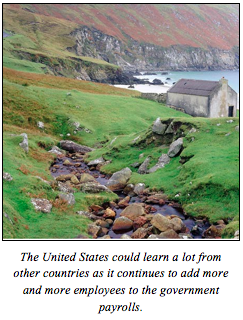ALG Editor’s Note: In the following featured op-ed published by the Montgomery Advertiser, ALG Chairman Howard Rich raises a highly important issue: the disparity of salary to public vs. private sector employees. The numbers are startling, and considering the deep budget problems faced across the nation, cutting public sector pay is the right place to start:
Irish know best way to deal with deficit

September 2nd, 2009
As states like California, Illinois and New Jersey struggle to make up for steep multi-billion dollar budget deficits while they totter on the brink of insolvency, there is one option for reducing those shortfalls that is making real headway across the Atlantic Ocean.
It all revolves around cutting the public sector. It’s time to try it here.
Ireland is faced with a 20 billion-euro deficit and borrowing 400 million euros a week just to keep afloat. Colm McCarthy, the chairman of An Bord Snip Nua—a cost-cutting bureau in Ireland—knows the stakes. And he sees no way around cutting public sector pay by some 5.3 billion euros. Government officials agree. So far, the left-of-center government refuses to rule anything out in the Bord Snip report.
Ireland is not alone. Poland just announced a cut of 12,000 government employees. No silly furloughs or dodgy accounting tricks. A straight reduction in the number of public sector workers.
The basic problems Ireland faces are quite similar to those in California, New York and other states in the U.S.: Public sector workers make far more than their private sector counterparts.
An October 2007 survey from Ireland’s Central Statistics Office showed that the average hourly earnings in the public sector were far greater than in the private sector. Public sector wages are 48 percent higher.
And how do California, Illinois and others match up?
According to the Bureau of Labor Statistics’ recently published study for 2007, in California, which is still trying to climb out of its oppressive $26 billion deficit, average annual income for state employees was $56,777 versus $49,935 for the private sector, a 14 percent gap. In Illinois, a similar story emerges: $53,925 for state workers, and $48,006 for the private sector, an 11 percent split. New Jersey: $57,845 average state salary, $53,590 for private sector workers, at an 8 percent difference.
And these differences don’t take into account the excessive fringe benefits enjoyed by public sector workers.
Nationally, the story is even worse. Federal workers made on average $64,871 in 2007, with private sector workers making a meager $44,362, so public sector wages in the federal system are 46 percent higher.
If California, and other spendthrift state governments ever hope to emerge in the black, they must now implement what some may consider draconian fiscal measures. Cutting public sector pay makes the most sense. In California, cutting the total workforce down by 10 percent is a real move that saves $5.4 billion annually and many billions more over time. Similar approaches would save taxpayers annually $1.3 billion in Illinois and New Jersey.
The Irish are on to something. By facing the reality of their situation head-on and acting in a responsible manner, they are far more likely to weather the financial storm than are the compulsive spenders. It is high time we embrace the pluck of the Irish here.
Howie Rich is Chairman of Americans for Limited Government.

